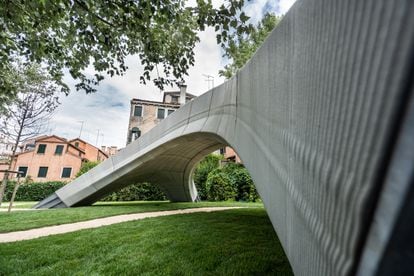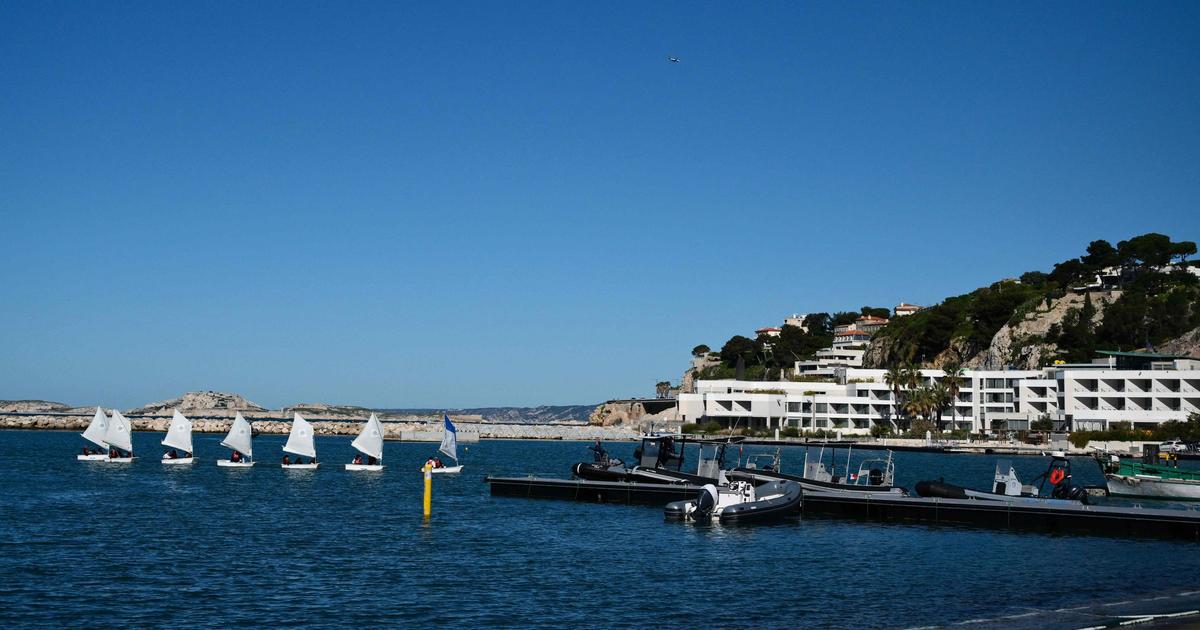Stratius is a pioneering bridge with a sinuous design that unfolds in three arms.
It is advertised as the first of its kind and functions more as a gate than a bridge.
It does not serve to overcome physical obstacles.
It is designed to move from one way of building to another more efficient and sustainable.
It is a pedestrian walkway that comes to open doors.
The architecture studio Zaha Hadid has devised the form, and the Block research group - attached to the Zurich ETH and made up of physicists and engineers - has calculated how to do it.
The company that produces special concretes Holcim has investigated to achieve the material that lightens the necessary amount of concrete (one third less than usual) to be able to manufacture each of the elements - joined without cement - in the construction of the bridge.
In Venice, it is Block's engineers who explain how each part of the bridge functions as a component of a puzzle, as one of the ancient stones held together with weight and pressure without intermediate mortar.
One of the three entrances, with wooden steps, of the Stratius bridge-walkway built during the Venice Biennale.Chiara Becattini
The bridge was built in two days, in mid-July, in the middle of the Marinaressa gardens, next to i Giardini where the national pavilions still show the proposals of the Venice Architecture Biennale today. It will remain, as a habitable sculpture (with floor and ceiling) until the Biennial closes in November. And in addition to offering views, shade, and building author and manufacturer reputations, the bridge should be food for thought. First of all, because it combines traditional ways of building — masonry — with state-of-the-art systems — 3-D printer production or robotics. It is about deep collaboration, not a sum of opposites. Although it is printed by a machine, the way to print the elements is by hand,to layers - hence the name of the Striatus bridge - "which reflects the structural logic of the manufacturing process," explain Block engineers. The concrete is printed in orthogonal layers to create a stressed ribbed structure that does not need reinforcement. That's why engineers talk about creating force with geometry: “It's about building more with less. It is Holcim's material, the new concrete, that makes it possible. It is more ecological because it needs less material. Also because it avoids waste - by allowing custom parts to be manufactured. Finally, because it allows dry and on-site construction with the consequent saving of water, energy and transport.That's why engineers talk about creating force with geometry: “It's about building more with less. It is Holcim's material, the new concrete, that makes it possible. It is more ecological because it needs less material. Also because it avoids waste - by allowing custom parts to be manufactured. Finally, because it allows dry and on-site construction with the consequent saving of water, energy and transport.That's why engineers talk about creating force with geometry: “It's about building more with less. It is Holcim's material, the new concrete, that makes it possible. It is more ecological because it needs less material. Also because it avoids waste - by allowing custom parts to be manufactured. Finally, because it allows dry and on-site construction with the consequent saving of water, energy and transport.
Detail of the concrete modules produced by a 3-D printer with a new lightweight concrete manufactured by the company Holcim.Chiara Becattini
In the producer of this new concrete, the Swiss company Holcim, they describe it as “a new artificial stone that works by compression.
And precise the precision of the design of structures It is the geometry that reinforces the construction (and the pieces with which it is built) and not the accumulation of material.
“The aluminum anchors absorb the horizontal thrust of the arches. Between each of the lightened concrete modules, which act as pieces of stonework, a piece of neoprene prevents the force from being concentrated at one point and helps to control friction as mortar does in historical construction "explain the engineers to describe this bridge without mortar, with a third less materials, printed in 3-D. They are talking about another way of building.









